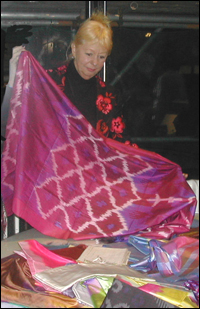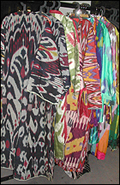Along the Silk Road: Silk Ikat Weaving in Uzbekistan
Jan 2007
Report by Judy Treddigan
On a grey wet evening in January we entered the comfortable senior common room at
the Royal College of Art to be transported on a magic carpet along the Silk Road
to Uzbekistan. There, engulfed in colourful silks of unimaginable hues and patterns,
we were introduced to Philippa Watkins, Senior Tutor Woven Textiles, at the Royal
College of Art.

It was her extraordinary beautiful collection of textiles that she had bought along
to share with us.
At the end of the Soviet period and the Communist ideology of collective working
Uzbekistan regained its independence. The textile weavers and dyers of the region
had difficulty with the new political and financial environment and had lost many
of the traditional craft and business skills.
Philippa had been invited to visit the region by The British Concil to lend her
expertise to help re-kindle and inspire the traditional skills of the weavers and
dyers and develop a new entrepreneurial spirit for their colourful textile crafts
that had had such a long and illustrious tradition. The focus of the exercise was
to create textiles and contemporary fashion for local consumption and export to
the West.
Philippa’s illustrated talk wove a fascinating story of the fading, crumbling beauty
of Central Asia with its exotic architecture, decorative arts and textiles. This
visual feast was interwoven with an erudite explanation of the political and economic
turmoil of Uzbekistan and the Mafia that has replaced Communism and, in its turn,
the effect it had on developing the new textile and fashion workshops. Despite all
these seemingly insurmountable problems, under Philippa and her team’s inspiration
the workshops started to produce ravishing textiles and fashions garments again,
not only using the technical and artistic mastery of traditional craft skills but
updating them, where appropriate, for consumption both at home and abroad.

To our immense relief Philippa explained with great patients all the complexities
of Ikat dying and weaving. It is a complex resist technique, tie dying the warp
threads in up to seven colours, each time the tied warps being taken from the loom
to be dyed and returned to the loom for the Master designer to indicate where the
next tying for resist will take place for the next colour. Finally, back on the
loom the ties are removed before being woven with the weft thread. (There is also
double Ikat, but for Uzbekistan single Ikat is used for the textiles) We were then
able to see in the slides, these ravishing textiles used in contemporary fashion
in a show masterminded by Philippa and her team.
Many questions were asked regarding the yarns used, which are mainly silk, and whether
the dyes were natural or chemical, both are, in fact, used. The dyer, we were told,
would use what ever he could find! Philippa was generous in sharing her knowledge
and expertise in answering the many queries from the floor.
Delegates were then invited to look at the many garments and textiles on display
and buy them or just admire the immense skill in creating such beauty.
The evening was masterminded by Sylvia Ayton in collaboration with Philippa Watkins;
we are indebted to both for such a magical, erudite exposition of the complexities
of the political and economic difficulties of the region but also for sharing with
us the exquisite beauty of the country, the textiles that are created in such a
politically unstable climate and with such basic equipment and facilities on the
Silk Road in Uzbekistan.